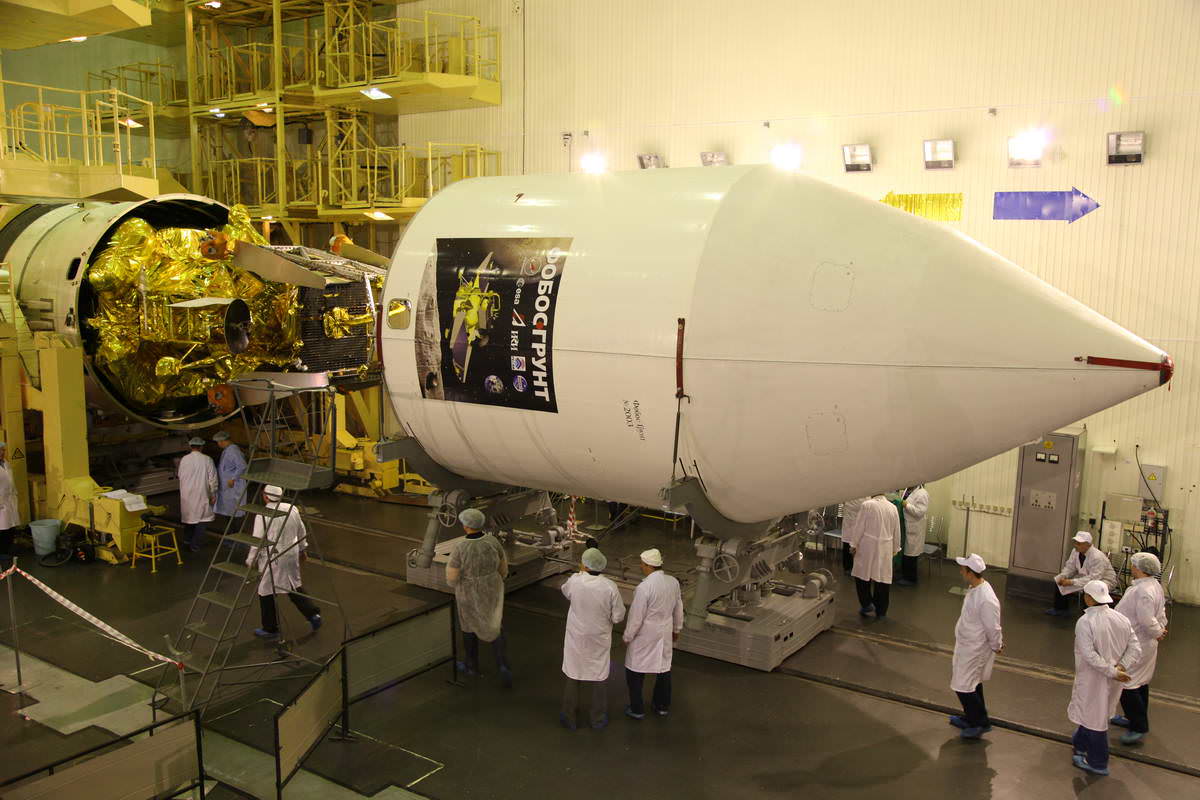[/caption]
Phobo-Grunt
, Russia's first interplanetary mission in nearly two decades, has now been encapsulated inside the payload fairing and sealed to the payload adapter for mating to the upper stage of the Zenit booster rocket that will propel the probe to
Mars orbit
and carry out history's first ever landing on the petite Martian moon
Phobos
and eventually return pristine samples to Earth for high powered scientific analysis.
"
Phobos-Grunt
will launch on November 9, 2011 at 00:16 a.m. Moscow time [Nov. 8 3:16 p.m. EST]," said Alexey Kuznetsov, Head of the Roscosmos Press Office in an exclusive interview with Universe Today. Roscosmos is the Russian Federal Space Agency, equivalent to NASA and ESA.
"The launch window extends until November 25."
"At this moment we are preparing the "Zenit-2SB" launch vehicle, the cruise propulsion system and the "Phobos Grunt" automatic interplanetary station at the
Baikonur Cosmodrome
," Kuznetzov told me.
Phobos-Grunt
translates as Phobos-Soil.
[caption id="attachment_90694" align="aligncenter" width="580" caption="Phobos-Grunt spacecraft attached to payload adapter prior to encapsulation. Note folded solar panels, gold colored sample transfer tube leading to return capsule, landing legs, antennae and propulsion tanks. Credit: Roscosmos"]
[/caption]
China's first ever
mission to Mars
, the
Yinghuo-1 micro-satellite
, is also encased inside the nose cone and is tucked in a truss segment between the lander and interplanetary propulsion stage.
Yinghuo-1
follows closely on the heels of
China's
stunning success in demonstrating the nation's first ever docking in space between two
Chinese spacecraft
earlier this week on November 3.
[caption id="attachment_90695" align="aligncenter" width="580" caption="Sealing up Phobos-Grunt. Credit: Roscosmos"]
[/caption]
Technicians completed the two vehicles enclosure inside the protective fairing at Building 31 at the
Baikonur Cosmodrome
and have now transported the spaceships to Building 41 where the payload is now being stacked to the upgraded "Fregat-SB" upper stage atop the Zenit-2SB rocket.
[caption id="attachment_90708" align="alignleft" width="250" caption="Martian moon Phobos imaged by Mars Express Orbiter from ESA. Credits: ESA/DLR/FU Berlin (G. Neukum)"]
[/caption] The payload fairing protects the Phobos-Grunt and Yinghuo-1 spacecraft during the first few minutes of flight from the intense frictional heating and buildup of aerodynamic pressures. After the rocket soars through the discernable atmosphere the fairing splits in half and is jettisoned and falls back to Earth.
The nose cone sports a beautiful mission logo painted on the side of the fairing along with the logos of various
Russian
and International partner agencies and science institutes.
[caption id="attachment_90696" align="aligncenter" width="580" caption="Phobos-Grunt payload fairing. Credit: Roscosmos"]
[/caption]
Propellants have already been loaded aboard the cruise stage, Phobos-Grunt lander and Earth return vehicle.
"The
Phobos Grunt
automatic interplanetary station was built, prepared and tested at NPO Lavochkin [near Moscow]. They were also responsible for inspection of the devices, instruments and systems integration," Kuzntezov explained.
"Significant improvements and modifications and been made to both the "Fregat-SB" upper stage and the "Zenit-2SB" rocket," said Kuznetzov.
[caption id="attachment_90697" align="alignleft" width="386" caption="View inside nose cone and preparing to encapsulate Phobos-Grunt. Click to enlarge. Credit: Roscosmos"]
[/caption] Phobos-Grunt will blastoff from Launch Pad 45 at Baikonur,
Following an 11 month journey, the spaceship will enter
Mars
orbit in October 2012, spend several months investigating Phobos and then land around February 2013.
The goal is to snatch up to 200 grams of soil and rock from Phobos and fly them back to Earth in a small capsule set to plummet through the atmosphere in August 2014.
ESA, the European Space Agency, is assisting Russia determine a safe landing site by targeting their Mars Express Orbiter to collect high resolution images of Phobos. Look at 2 D and 3 D images and an animation
here
.
The regolith samples will help teach volumes about the origin and evolution of Phobos, Mars and the Solar System. Scientists would be delighted if miniscule bits of Martian soil were mixed in with Phobos soil.
Phobos-Grunt , Earth's next mission to Mars, is equipped with an advanced 50 kg payload array of some 20 science instruments.
NASA's
Curiosity Mars rover
was also enclosed in her payload fairing a few days ago and is on course for liftoff on November 25.
[caption id="attachment_90699" align="aligncenter" width="580" caption="The Phobos-Grunt spacecraft is scheduled to blastoff on November 9, 2011 from Baikonur Cosmodrome. It will reach Mars orbit in 2012 and eventually land on Phobos and return the first ever soil samples back to Earth in 2014. Credit Roscosmos"]
[/caption]
Read Ken's continuing features about Phobos-Grunt here:
Phobos and Jupiter Conjunction in 3 D and Amazing Animation – Blastoff to Martian Moon near
Russia Fuels Phobos-Grunt and sets Mars Launch for November 9
Phobos-Grunt and Yinghou-1 Arrive at Baikonur Launch Site to tight Mars Deadline
Phobos-Grunt: The Mission Poster
Daring Russian Sample Return mission to Martian Moon Phobos aims for November Liftoff
Read Ken's continuing features about Curiosity & Nov. 25 launch starting here:
Closing the Clamshell on a Martian Curiosity
Curiosity Buttoned Up for Martian Voyage in Search of Life's Ingredients
Assembling Curiosity's Rocket to Mars
Encapsulating Curiosity for Martian Flight Test
Dramatic New NASA Animation Depicts Next Mars Rover in Action
 Universe Today
Universe Today
